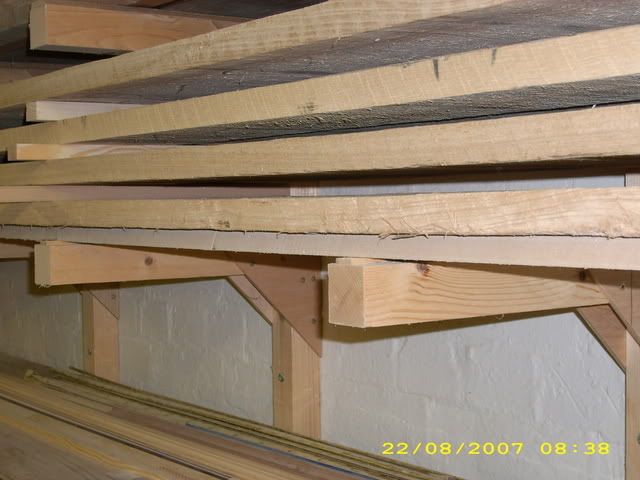I'm planning on knocking up a few rough wooden brackets for supporting shelves in the garage soon. Thing is I'll be sawing them by hand and as I don't want to spend much time on them the joints will most likely be a bit sloppy. So can anyone give me advice on what adhesives are good at filling gaps. I know that epoxy (with micro fibres mixed in) performs this function well but this is much too expensive to waste on a bit of rough shelving.
I was thinking of Gripfill but I just have this prejudice that the stuff - great an' all as it is - isn't a proper wood glue. It's very bulky - almost like putty it seems - and so is difficult to get into crevices and corners IMV. Plus, if you do fill a gap with it it seems to take a few days to harden. And at that, does Grip fill really harden fully like resin based adhesives? I can't get this idea out of my head that anything that comes in a cartridge is just a super duper form of silicone and will never lose its rubberiness, causing it to creep over time. I know, I know... Gripfill is a proper adhesive and not just a sealant, but still... it comes in a cartridge! :shock:
The other concern I have is that to work properly I thought wood glue had to soak into the wood fibres of the mating surfaces in the joint. But Gripfill being a bit putty-like - or should that be more solid than liquid - just seems to sit on the surface. So, despite what it says on the packaging, how well does it really bond wood?
Furthermore, from searching the forum archives I've read that formaldehyde adhesives are also good at filling gaps. As I have a pot of Humbrol's Cascamite/Extramite/Polymite/Whatevertheyarecallingitnow-mite (urea formaldehyde I believe) this might be a better option than Gripfill. But the thing about 'mite (for want of a consistent name) that concerns me is how big a gap it can cope with before losing its strength. 'Mite is also reputed to be quite brittle so if the space is too great does this raise the possibility of the glue 'line' fracturing if knocked?
Another seeming downside of 'mite in comparison to Gripfill or Epoxy (with plenty of micro fibres) is that it's too runny to stay in large crevices. Is there anything you can mix into it (like the micro fibres you can get for epoxy) that will thicken it into more of a paste? I've been told sawdust but does this not compromise the strength of the adhesive? Could you get away with mixing the micro fibres that SP or West sell with their epoxy into 'mite as this would not only bulk the adhesive up but also strengthen it across a gap? The thinking being that micro fibres act a bit like the fibrous matting in glass-fibre? Or would something designed for epoxy be chemically incompatible with a urea formaldehyde adhesive?
Yours,
The ever bewildered woden. :?
I was thinking of Gripfill but I just have this prejudice that the stuff - great an' all as it is - isn't a proper wood glue. It's very bulky - almost like putty it seems - and so is difficult to get into crevices and corners IMV. Plus, if you do fill a gap with it it seems to take a few days to harden. And at that, does Grip fill really harden fully like resin based adhesives? I can't get this idea out of my head that anything that comes in a cartridge is just a super duper form of silicone and will never lose its rubberiness, causing it to creep over time. I know, I know... Gripfill is a proper adhesive and not just a sealant, but still... it comes in a cartridge! :shock:
The other concern I have is that to work properly I thought wood glue had to soak into the wood fibres of the mating surfaces in the joint. But Gripfill being a bit putty-like - or should that be more solid than liquid - just seems to sit on the surface. So, despite what it says on the packaging, how well does it really bond wood?
Furthermore, from searching the forum archives I've read that formaldehyde adhesives are also good at filling gaps. As I have a pot of Humbrol's Cascamite/Extramite/Polymite/Whatevertheyarecallingitnow-mite (urea formaldehyde I believe) this might be a better option than Gripfill. But the thing about 'mite (for want of a consistent name) that concerns me is how big a gap it can cope with before losing its strength. 'Mite is also reputed to be quite brittle so if the space is too great does this raise the possibility of the glue 'line' fracturing if knocked?
Another seeming downside of 'mite in comparison to Gripfill or Epoxy (with plenty of micro fibres) is that it's too runny to stay in large crevices. Is there anything you can mix into it (like the micro fibres you can get for epoxy) that will thicken it into more of a paste? I've been told sawdust but does this not compromise the strength of the adhesive? Could you get away with mixing the micro fibres that SP or West sell with their epoxy into 'mite as this would not only bulk the adhesive up but also strengthen it across a gap? The thinking being that micro fibres act a bit like the fibrous matting in glass-fibre? Or would something designed for epoxy be chemically incompatible with a urea formaldehyde adhesive?
Yours,
The ever bewildered woden. :?






